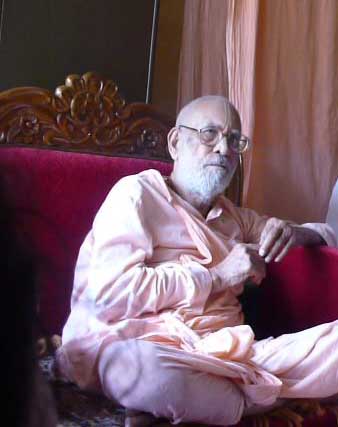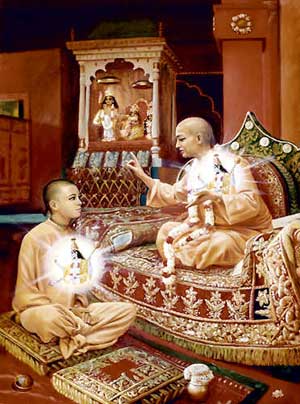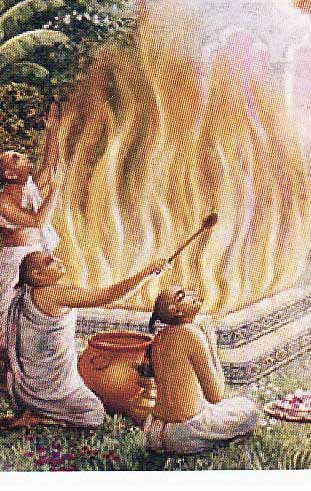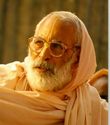

Bangalore, India: December 16, 2007
I want to say something regarding a certain matter.
Nowadays, some people have begun to follow the ritvik doctrine.* Having left the actual guru-parampara, they have accepted the ritvik parampara. But the ritvik doctrine has no relationship with spirituality (paramartha). Ritviks simply perform fire sacrifices (yajnas), take some payment (daksina), and then depart.
The guru-parampara descends from Sri Krsna to Brahma, Brahma to Narada, Narada to Vyasa, Vyasa to Madhvacarya, Madhvacarya to Laksmipati, Laksmipati to Madhavendra Puri, to Isvara Puri, to Sri Caitanya Mahaprabhu, to Svarupa Damodara Gosvami, to the Six Gosvamis, and … to Srila Bhaktivinoda Thakura, and it is descending down to the present day.
If a person does not take diksa in the line of the parampara, pure bhakti can never come to him. The four paramparas and their acaryas are:

The ritviks have no relationship with this. If the ritvik doctrine does not accept the guru-parampara, it is against bhakti. Having said this, I am ending my discussion (vaktavya, literally meaning 'that which should be said').
[*Endnote – Excerpts from Srila Narayana Gosvami's "True Conception of Guru-tattva"
tad viddhi pranipatenaFor understanding the Supreme Absolute Reality, which is the topmost benefit of the jiva, one must approach a guru who has realized the truth. By offering him obeisances, inquiring submissively from him, and rendering service to him, you should please him. Thus pleased, he will bestow upon you knowledge of jiva-tattva (the pure constitutional nature of the self), para-tattva (the nature of Supreme Absolute Reality), and bhakti-tattva (the nature of devotion to Sri Krsna). After knowing all these truths, your human life will be successful.
pariprasnena sevaya
upadeksyanti te jnanam
jnaninas tattva-darsinah
[Gita, 4.34]"Just try to learn the truth by approaching a spiritual master. Inquire from him submissively and render service unto him. The self-realized souls can impart knowledge unto you because they have seen the truth."
It is clear that the tattva-darsi (self-realized) guru imparts knowledge of only bhagavata-tattva, bhakti-tattva, and atma-tattva. He has nothing to do with the fulfillment of one's temporary mundane desires.
It is said in the Upanisads:
tad-vijnanartham sa gurum evabhigacchetFor attaining vijnana (knowledge with prema-bhakti) of the supreme Absolute Entity, carrying samidha (wood for the sacrifice), which is considered to be representative of sublime faith, one must approach with complete surrender of body, mind, and words, a guru who knows the tattva of Krsna and the essence of the Vedas.
samit-panih srotriyam brahma-nistham
[Mundaka Upanisad, 1.2.12]"To learn the transcendental subject matter, one must approach a spiritual master. In doing so, he should carry fuel to burn in sacrifice. The symptom of such a spiritual master is that he is expert in understanding the Vedic conclusions, and therefore he constantly engages in the service of the Supreme Personality of Godhead."
Furthermore it is said in Svetasvatara Upanisad (6.23):
yasya deve para bhaktirA similar statement is found in Srimad-Bhagavatam:
yatha deve tatha gurau
tasyaite kathita hy arthah
prakasante mahatmanah"Only in the hearts of great saints, those who have transcendental devotion (para-bhakti) unto the Supreme Lord and also toward their Gurudeva, is the essence of all the Vedas revealed."
tasmad gurum prapadyetaBhakti, loving service to the lotus feet of Sri Krsna, is the only auspicious path for the jivas. To know this, the inquisitive sadhakas (practitioners) must take shelter of the lotus feet of a sad-guru. Only one who is very expert in the understanding of sabda-brahma (the conclusions of the Vedas), who has realized the Supreme Absolute Truth and who is never over-powered by mundane sense objects or miseries, is a sad-guru. In Sri Caitanya-caritamrta, this conclusion is also established:
jijnasuh sreya uttamam
sabde pare ca nisnatam
brahmany upasamasrayam
[Srimad-Bhagavatam: 11.3.21]"Any person who seriously desires to achieve real happiness must seek out a bona fide spiritual master and take shelter of him by initiation. The qualification of the spiritual master is that he must have realized the conclusion of the scriptures by deliberation, and must be able to convince others of these conclusions. Such great personalities, who have taken shelter of the Supreme Godhead, leaving aside all material considerations, are to be understood as bona fide spiritual masters."
brahmanda bhramite kona bhagyavan jiva
guru-krsna-prasade paya bhakti-lata-bija
[Cc Madhya, 19.151]"According to their karma, all living entities are wandering throughout the entire universe. Some of them are being elevated to the upper planetary systems, and some are going down into the lower planetary systems. Out of many millions of wandering living entities, one who is very fortunate gets an opportunity to associate with a bona fide spiritual master by the grace of Krsna. By the mercy of both Krsna and the spiritual master, such a person receives the seed of the creeper of devotional service."
tate krsna bhaje, kare gurura sevana
maya-jala chute, paya krsnera carana
[Cc Madhya, 22.25]"If the conditioned soul engages in the service of the Lord and simultaneously carries out the orders of his spiritual master and serves him, he can get out of the clutches of maya and become eligible for shelter at Krsna's lotus feet."

On the other hand, the relationship between the yajman (the person who undertakes a fire sacrifice in order to fulfill some material desire, and on whose behalf the priest, or ritvik, performs the fire sacrifice) and the ritvik is temporary and based on self-interest. It is for the fulfillment of mundane desires. Their relationship lasts for a short time only. Therefore, since time immemorial, the system of guru-parampara, which is also known as amnaya or sat-sampradaya, has been prevalent in the scriptures. The four lines of bona fide succession of spiritual masters have originated from the associates of the Lord, that is, Sri Laksmi, Sri Brahma, Sri Rudra and Sri Sanat-kumara. In the age of Kali, Sri Ramanujacarya, Sri Madhvacarya, Sri Visnusvami and Sri Nimbaditya respectively are the four acaryas famous as the followers of the above personalities. Guru-parampara (the bona fide succession of spiritual masters) is always prevalent in the amnaya line of these four acaryas. Even in the advaita-sampradaya (followers of Sankaracarya), the tradition of guru-parampara is well preserved.
[Question:] How does a disciple relate with his guru once he has entered in aprakata-lila (the guru's entrance into the eternal pastimes of Krsna in the spiritual world)? Like Srila Bhaktivedanta Swami Prabhupada's disciples, those who took initiation when he was still physically present. How can they relate with him since he is now in aprakata-lila?
[Srila Narayana Maharaja:] A disciple should think, "He is my Gurudeva. He is eternal. He is still here." When we pray for anything, he will inspire us. He is eternal, everywhere, and in our hearts also. He has not left his body. His body, his everything, is transcendental. So don't worry. Our relationship with him is the same as it was.
[Question:] Does the example of Sri Madhvacarya approaching Srila Vyasadeva show that an aspiring disciple can, so to speak, summon a departed acarya who has entered into aprakata-lila, and request initiation from him? Of course, Madhvacarya was in a special situation. He was an empowered expansion of the Lord. He was one of the four sampradaya acaryas.
[Srila Narayana Maharaja:] Madhvacarya was a direct disciple of Srila Vyasadeva. When Madhvacarya was living, about 4000 years had passed since Vyasa had disappeared from the vision of this world. However, Madhvacarya knew that Vyasadeva was still alive and that he is eternal. So he prayed to him in Badrikasrama, beseeching him, "I want to take your darsana and to be initiated by you." When he was praying, Vyasadeva personally came there, and Madhvacarya presented his wish to him, that he would give Madhvacarya initiation. After that, Vyasa disappeared.
So guru is like this. However, those who do not understand the correct siddhanta (conclusive philosophical truths) and are not very learned, and who have not developed their bhakti to the level of madhyama-uttama-adhikari or uttama-adhikari, cannot realize all these truths. And certainly a kanistha-adhikari is not able to realize all these things. Such persons, being bewildered, may try to take help from the ritvik philosophy or some other ideology which is not our siddhanta.
Editorial advisors: Pujyapad Madhava Maharaja, Sripad Brajanath dasa, and Sri Prema Prayojana dasa
Assistant Editor: Hariballabha dasi
Editor: Syamarani dasi
Proof-reader: Krsna-kamini dasi
HTML: Bhutabhavana dasa
Paintings copyright Bhaktivedanta Book Trust International. Used with permission.
![[BVML Home Page]](../../grfx/bml_logo.gif)
